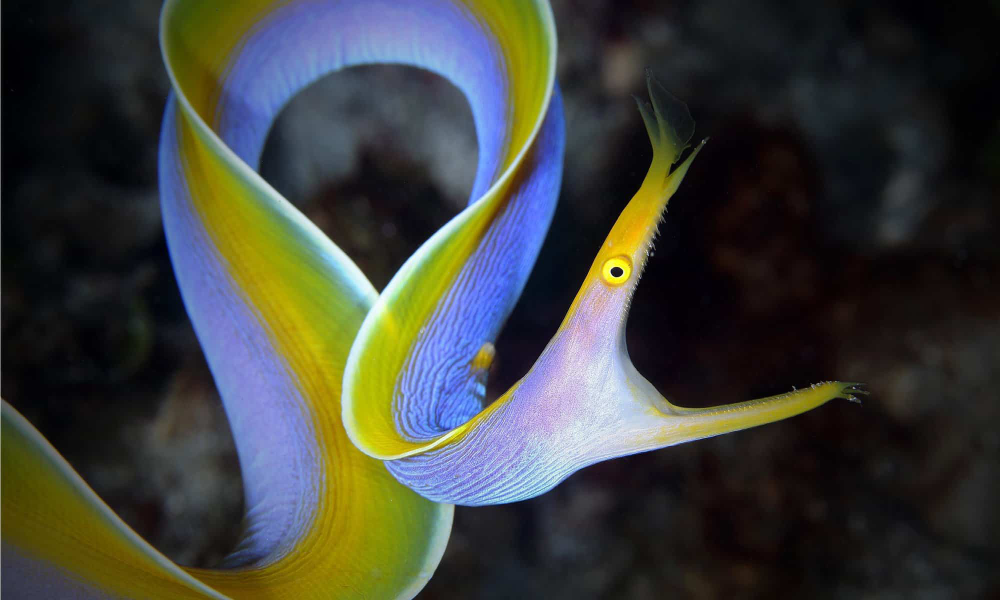The Ribbon Eel, scientifically known as Rhinomuraena quaesita, is a captivating and enigmatic species that inhabits the warm, tropical waters of the Indo-Pacific region. Its vibrant colors, unique body structure, and fascinating life cycle make it a subject of great interest for marine biologists and aquarium enthusiasts alike. This article delves into the various aspects of the Ribbon Eel, including its habitat, physical characteristics, behavior, diet, reproduction, and conservation status.
Habitat and Distribution
Ribbon Eels are predominantly found in the coastal waters of the Indo-Pacific, extending from East Africa to southern Japan and Australia. They thrive in coral reefs and lagoons, where they seek shelter within crevices and sand burrows. These eels prefer shallow waters, usually between 1 to 60 meters deep, where they can easily access their prey and evade predators.
The species’ preference for specific habitats highlights the importance of coral reefs in maintaining marine biodiversity. Coral reefs provide the structural complexity and resources necessary for Ribbon Eels to thrive. Unfortunately, these ecosystems are under threat from climate change, pollution, and overfishing, which indirectly impacts the Ribbon Eel population.
Physical Characteristics
The Ribbon Eel is popular for its striking appearance, characterized by an elongated, ribbon-like body that can grow up to 1.3 meters in length. It exhibits a unique color-changing ability throughout its life, which is closely tied to its sex and age. Juvenile Ribbon Eels are typically jet black with a yellow dorsal fin, a color scheme that gradually changes as they mature.
Male Ribbon Eels transition to a bright blue body with a yellow dorsal fin and mouth, while females turn a uniform yellow or yellow-green. This remarkable color transformation is not only a visual spectacle but also a rare example of sequential hermaphroditism in marine species, where an individual can change its sex from male to female as it ages.
The eel’s narrow head, tubular nostrils, and sharp teeth are well-adapted for its predatory lifestyle. The nostrils, resembling small trumpets, are particularly distinctive and serve a critical function in detecting prey through chemoreception.

Behavior and Diet
Ribbon Eels are primarily nocturnal and solitary creatures, spending most of their lives concealed within the safety of their burrows. They exhibit a sit-and-wait hunting strategy, where they remain partially hidden with only their heads protruding from their shelters. This ambush technique allows them to swiftly strike at passing prey with precision.
Their diet consists mainly of small fish and crustaceans, which they capture with their sharp teeth and strong jaw muscles. Ribbon Eels rely heavily on their acute sense of smell to locate prey, a necessity given their often murky and dimly lit habitats.
Reproduction and Life Cycle
The Ribbon Eel’s reproductive behavior is as fascinating as its physical transformation. These eels are protandric hermaphrodites, meaning they start life as males and later change to females. This sequential hermaphroditism is believed to be advantageous in maximizing reproductive success, as larger individuals, which are typically females, can produce more eggs.
During the breeding season, males attract females by performing elaborate displays. Fertilization occurs externally, with the female laying eggs that are then fertilized by the male. The eggs hatch into larvae, which drift in the planktonic stage for several months before settling on the ocean floor and developing into juvenile eels.
Conservation Status and Threats
Currently, the Ribbon Eel is not an endangered species. However, like many marine organisms, it faces threats from habitat destruction, pollution, and the aquarium trade. Coral reef degradation poses a significant risk to their natural habitat, while overcollection for the aquarium industry can deplete local populations.
Conservation efforts are essential to ensure the sustainability of Ribbon Eel populations. Protecting coral reefs, regulating the aquarium trade, and promoting awareness about the ecological importance of these eels are critical steps toward their preservation.
The Ribbon Eel in Aquariums
Ribbon Eels are popular among aquarium enthusiasts due to their vivid colors and intriguing behavior. However, they are notoriously difficult to keep in captivity. Their specialized diet, need for ample hiding spaces, and sensitivity to water conditions make them challenging to care for. Furthermore, the stress of captivity can hinder their natural behaviors and shorten their lifespan.
For those determined to keep Ribbon Eels, it is crucial to replicate their natural environment as closely as possible. This includes providing a deep sand bed for burrowing, plenty of rock structures for hiding, and a diet of live or frozen fish and crustaceans. Additionally, maintaining pristine water quality and stable parameters is vital for their well-being.
Conclusion
The Ribbon Eel stands out as one of the most visually striking and behaviorally intriguing inhabitants of the Indo-Pacific reefs. Its vibrant colors, unique life cycle, and elusive nature make it a fascinating subject for study and admiration. So, by protecting this species and its habitat is essential to preserving the delicate balance of marine ecosystems and ensuring that future generations can continue to marvel at the wonders of the underwater world. As we deepen our understanding of the Ribbon Eel, we also gain insights into the broader complexities of ocean life and the interdependence of all marine species.









